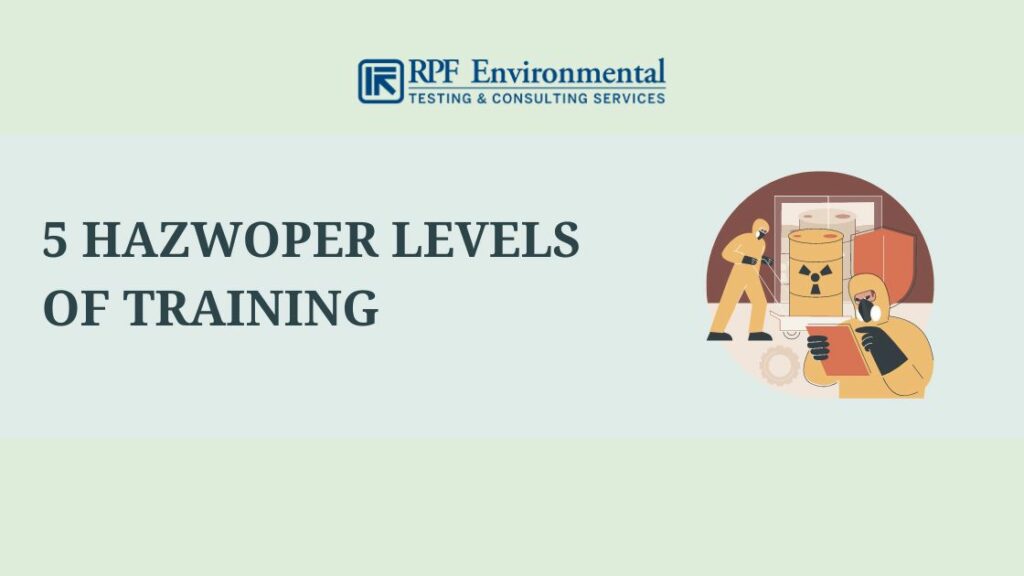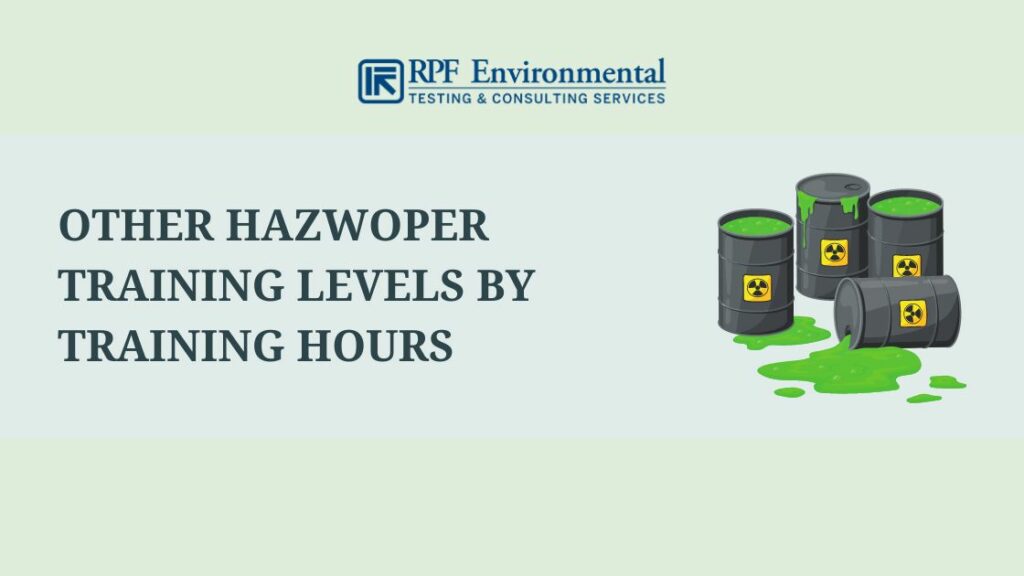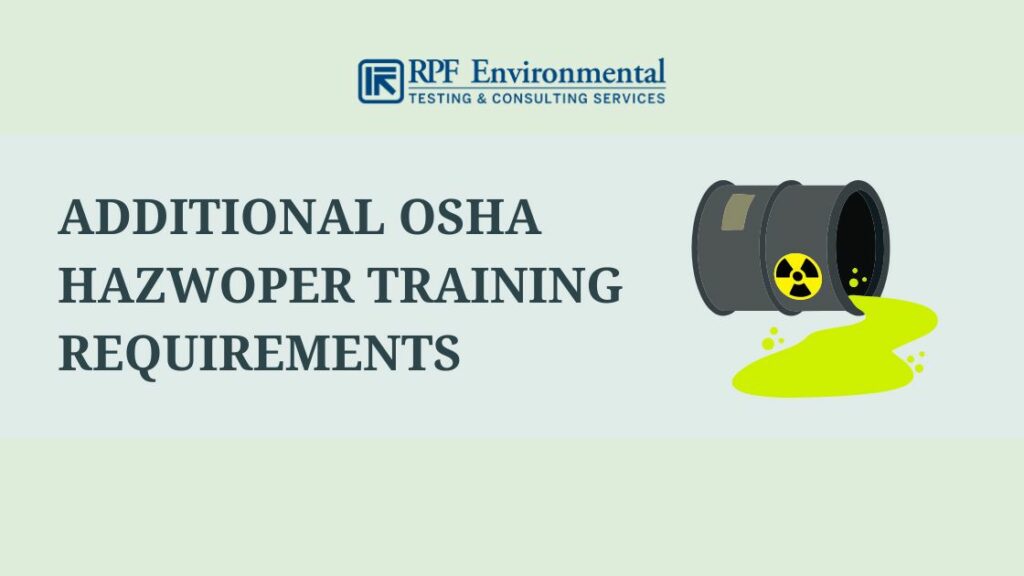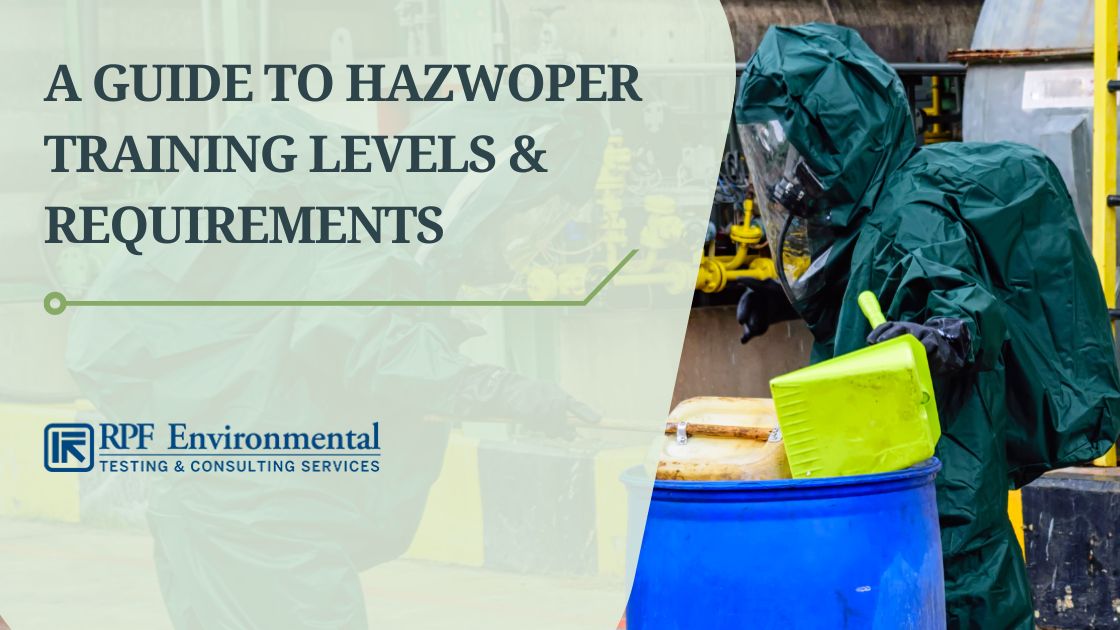The Hazardous Waste Operations and Emergency Response (HAZWOPER) standard, which was covered by OSHA under 29 CFR 1910.120, listed five HAZWOPER training levels for emergency responders:
- First Responder Awareness (FRA) Level
- First Responder Operations (FRO) Level
- Hazardous Materials Technician
- Hazardous Materials Specialist
- On-Scene Incident Commander
In addition, there are three types of HAZWOPER training (8-hour, 24-hour, and 40-hour). Read on to learn more about these levels and types in detail here!

RPF Environmental offers OSHA HAZWOPER training and other environmental health and safety training programs including Illinois, Indiana, Maine, Massachusetts, and New Hampshire. We also offer hazardous material surveys. Reach out to our experts for more information!
5 HAZWOPER Levels of Training

As stated by OSHA, new employees who will participate in emergency response operations should undergo training based on the function they’re going to perform. They need to be HAZWOPER-certified before they get involved in actual emergency operations.
Below are the five levels of HAZWOPER training:
Level 1. [1910.120(q)(6)(i)] First Responder Awareness (FRA) Level
The HAZWOPER awareness level training is for workers who might discover or witness the release of a hazardous substance while they’re on the job. They can also be referred to as the initial observers who are responsible for notifying the right authorities about the release and should not take further action beyond that.
What’s Covered in the Training
- Understanding hazardous substances, their risks, and potential outcomes when emergencies are created
- Recognizing and identifying hazardous substances
- Understanding their role in emergency response plans
- Discerning if additional resources are needed
- Making appropriate notifications
Examples of Training
- Setting off alarms
- Announcing over intercoms
- Calling 911 or security
- Contacting HAZMAT teams
Level 2. [1910.120(q)(6)(ii)] First Responder Operations (FRO) Level
This is for first responders who respond defensively to hazardous substance releases and potential releases to protect nearby individuals, properties, and the environment. They are only responsible for containing the release and not stopping it to prevent further exposure.
What’s Covered in the Training
First responders at this level need to have eight hours or more of training in the following areas in addition to the ones listed in Level 1:
- Implementing basic decontamination procedures
- Understanding basic hazardous materials terms
- Basic techniques for hazard and risk assessment
- Proper use of personal protective equipment
- Performing basic control, confinement, and/or containment operations
- Understanding relevant standard termination and operating procedures
Examples of Training
- Evacuating or isolating the area
- Minimizing the spread of the release
- Preserving evidence
Level 3. [1910.120(q)(6)(iii)] Hazardous Materials Technician
For individuals who are responsible for stopping the release, their role is more aggressive than first responders at the operations level. They will go to the source of the hazardous substance release to plug, patch, or stop it.
What’s Covered in the Training
Hazardous materials (HAZMAT) technicians should have at least 24 training hours covering the areas in the first responder operations level along with competency in:
- Implementing their employer’s emergency response plan
- Understanding hazard and risk assessment techniques and termination procedures
- Understanding and implementing decontamination procedures
- Understanding basic toxicological and chemical behavior and terminology
- Functioning within a role in the Incident Command System
- Selecting and using the right specialized chemical PPE provided to them
- Using field survey equipment and instruments to classify, identify, and verify known and unknown materials
- Performing advanced confinement, control, and/or containment operations
Level 4. Hazardous Materials Specialist [1910.120(q)(6)(iv)]
For HAZMAT specialists, their duties are the same as HAZMAT technicians but their role requires more specific knowledge about hazardous substances. Aside from providing additional support to HAZMAT technicians, HAZMAT specialists also act as site liaisons with involved authorities.
What’s Covered in the Training
HAZMAT specialists should receive at least 24 training hours that include the HAZMAT technician training and competency in:
- Implementing local emergency response plans
- Understanding chemical, toxicological, and radiological terminology and behavior
- Developing site safety and control plans
Level 5. [1910.120(q)(6)(v)] On-Scene Incident Commander
On-scene incident commanders are the ones assigned to the overall management of emergencies. Their tasks include strategizing and implementing objectives and tactics for handling risks.
What’s Covered in the Training
Incident commanders should undergo at least 24 training hours including the ones covered in the first responder operations level training as well as competency in:
- Implementing incident command systems and emergency response plans
- Knowing and understanding associated risks and hazards with workers in chemical protective clothing
- Knowing and understanding how important decontamination procedures are
- Knowledge about the Federal Regional Response Team
Other HAZWOPER Training Levels By Training Hours

In addition to the five levels above, there are also three types of HAZWOPER training classified by the number of required training hours. Your role and duties will determine how many training hours you will need.
8-Hour HAZWOPER Training
Also referred to as the OSHA 8-hour HAZWOPER refresher training, this type of training should be taken each year. However, you need to complete a 24-hour or 40-hour training first before you can take the annual refresher training.
24-Hour HAZWOPER Training
This is usually for occasional workers assigned to limited tasks who are less likely to be exposed to hazardous substances. It is often accompanied by a supervised one-day field experience.
40-Hour HAZWOPER Training
This training should be taken by new workers who will be dealing with hazardous substances. Aside from the 40-hour training, they also need to complete three days of supervised field experience.
When Is HAZWOPER Training Required?
As specified under 29 CFR 1910.120(a)(1), the following operations that involve employee exposure require HAZWOPER training:
- Clean-ups required by governmental bodies involving hazardous substances
- Corrective actions at hazardous sites
- Voluntary clean-ups at recognized uncontrolled hazardous waste sites;
- Operations at treatment, storage, and disposal (TSD) sites
- Emergency response operations involving the release or potential release of hazardous substances
Additional OSHA HAZWOPER Training Requirements

Aside from the HAZWOPER requirements mentioned beforehand, below are some additional training requirements by OSHA:
Who Needs HAZWOPER Training?
There are three general categorizations of employees that need to undergo HAZWOPER training:
1. [1910.120(e)] General On-Site Workers
These include those working on-site who are exposed to hazards such as:
- General laborers
- Equipment operators
- Management supervising employees working in hazardous operations
In addition, these workers (including on-site supervisors and management) should receive a minimum of 40 training hours and three days of actual field experience. The following can take a minimum of 24 training hours and a one-day field experience:
- Occasional on-site workers like those performing geophysical surveying and groundwater monitoring
- Regular workers in sites that don’t indicate health hazards
2. [1910.120(p)] Workers in TSD Facilities
New employees working in TSD facilities should receive an initial training of 24 hours along with an annual eight-hour refresher training.
3. [1910.120(q)] Emergency Responders
As mentioned in the 5 HAZWOPER levels of training, the type of training and the number of hours required for emergency responders will be based on their duties and function. They shall receive either a minimum of eight or 24 training hours.
Other Specific Types of Workers Who Need HAZWOPER Training
- On-site incident commanders
- HAZMAT technicians, materials specialists, and supervisors
NOTE: Anyone who doesn’t have a HAZWOPER certification should not be allowed to take part in hazardous waste operations.
HAZWOPER Refresher Requirements
General on-site workers, supervisors, and managers should receive an annual 8-hour refresher training. This training includes the following items as specified in sections (e)(2) and/or (e)(4) of the HAZWOPER standard:
- Hazards on the site
- Using PPE
- Practices for minimizing hazard risks
- Using on-site equipment safely
- Medical surveillance requirements
- Elements addressed in the site safety and health plan under 1910.120(b)(4)(ii)
Other HAZWOPER Training Requirements by OSHA
- For hospital staff. They should undergo first-responder operations level training emphasizing PPE use and decontamination procedures along with an annual refresher training.
- For on-site workers who do not take part in cleanup operations directly. On-site workers like utility workers at sites where contaminations are expected should also be fully trained with a minimum of 24 or 40 hours.
Where Can You Find All HAZWOPER Requirements?
You can find a detailed discussion of the HAZWOPER standard along with training requirements in OSHA’s standard number 29 CFR 1910.120.
Also Read: HAZWOPER vs. HAZMAT
FAQs
HAZWOPER has five levels of training for emergency responders:
Level 1. First Responder Awareness (FRA) Level
Level 2. First Responder Operations (FRO) Level
Level 3. Hazardous Materials Technician
Level 4. Hazardous Materials Specialist
Level 5. On-Scene Incident Commander
The three general HAZWOPER training types are 8-hour refresher training, 24-hour, and 40-hour HAZWOPER training.
HAZWOPER 24 is usually for occasional site workers who perform limited tasks and are unlikely to be exposed to hazardous substances. On the other hand, HAZWOPER 40 is for new full-time employees who will be working with hazardous substances.
The OSHA HAZWOPER awareness level training is for workers who are likely to discover the release of hazardous substances while doing their job. They are only responsible for notifying involved authorities and not for containing or stopping the release.
Conclusion
Anyone involved in working with or will be exposed to hazardous substances, employees and supervisors alike, should receive a minimum of 24 or 40 hours of training. They should also take an annual 8-hour refresher training as required by OSHA. Without a HAZWOPER certification, you’re prohibited from involving yourself in any hazardous waste operations.
Contact RPF Environmental for details about OSHA HAZWOPER training and other environmental health and safety training programs. We serve clients in Maine, Massachusetts, New Hampshire, and other areas in the US. We also provide hazardous material surveys.




